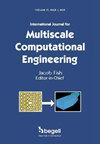Further development of GDEM for the modelling of multi-scale dynamic response of rock subjected to blasting and impact
IF 1.4
4区 工程技术
Q2 ENGINEERING, MULTIDISCIPLINARY
International Journal for Multiscale Computational Engineering
Pub Date : 2023-12-01
DOI:10.1615/intjmultcompeng.2023049685
引用次数: 0
Abstract
The dynamical responses of rock subjected to blasting and impact have been concerned in most underground projects. Due to the size effects and strain rate enhancement induced by inertial effects, the dynamic responses of rock and underground structures show multi-scale characteristics. Thus, in order to achieve better understanding of multi-scale dynamic responses of rocks, both computation accuracy and numerical efficiency have been taken into account. This is achieved by further development of a continuum–discontinuous element method code, called GDEM, with a new type of dynamic bounding surface damage model being implemented, thus forming a bounding surface dynamic plasticity damage-GDEM model (DB-GDEM). Both continuous and discontinuous mechanical behaviours of rocks have been captured well by the newly developed DB-GDEM model. The main multi-scale dynamic characteristics of rock subjected to blasting and impact, including particle movement, fragmentation of rock mass, stress wave propagation, and failure models, have been captured. Good agreement among modelling results and solutions reported in literature demonstrates the capability of DB-GDEM. The introduction of bounding surface plasticity damage model in GDEM would reproduce a more realistic dynamic damage response of rock compared with the original GDEM model that embedded with conventional constitutive models.进一步开发 GDEM,用于模拟岩石在爆破和冲击作用下的多尺度动态响应
在大多数地下工程中,岩石在爆破和冲击作用下的动态响应一直受到关注。由于惯性效应引起的尺寸效应和应变速率增强,岩石和地下结构的动态响应呈现多尺度特征。因此,为了更好地理解岩石的多尺度动态响应,需要同时考虑计算精度和数值效率。为此,我们进一步开发了连续-非连续单元法代码(GDEM),并采用了新型的边界面动态损伤模型,从而形成了边界面动态塑性损伤-GDEM 模型(DB-GDEM)。新开发的 DB-GDEM 模型很好地捕捉了岩石的连续和不连续力学行为。模型捕捉到了岩石在爆破和冲击作用下的主要多尺度动态特征,包括颗粒运动、岩体破碎、应力波传播和破坏模型。建模结果与文献报道的解决方案之间的良好一致性证明了 DB-GDEM 的能力。与嵌入传统构造模型的原始 GDEM 模型相比,在 GDEM 中引入边界面塑性破坏模型将再现更真实的岩石动态破坏响应。
本文章由计算机程序翻译,如有差异,请以英文原文为准。
求助全文
约1分钟内获得全文
求助全文
来源期刊
CiteScore
3.40
自引率
14.30%
发文量
44
审稿时长
>12 weeks
期刊介绍:
The aim of the journal is to advance the research and practice in diverse areas of Multiscale Computational Science and Engineering. The journal will publish original papers and educational articles of general value to the field that will bridge the gap between modeling, simulation and design of products based on multiscale principles. The scope of the journal includes papers concerned with bridging of physical scales, ranging from the atomic level to full scale products and problems involving multiple physical processes interacting at multiple spatial and temporal scales. The emerging areas of computational nanotechnology and computational biotechnology and computational energy sciences are of particular interest to the journal. The journal is intended to be of interest and use to researchers and practitioners in academic, governmental and industrial communities.

 求助内容:
求助内容: 应助结果提醒方式:
应助结果提醒方式:


